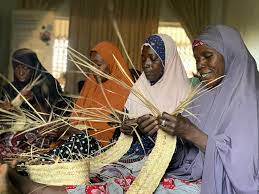
Between January and March 2021, the agriculture contributed to twenty-two point thirty-five percent (22.35%) of the total gross domestic product (GDP) and over seventy percent (70%) of Nigerians engage in the agriculture sector mainly at a subsistence level.
Despite the contribution to the economy, Nigeria’s agricultural sector faces many challenges which impact on its productivity. These include; poor land tenure system, low level of irrigation farming, climate change and land degradation. Others are low technology, high production cost and poor distribution of inputs, limited financing, high post-harvest losses and poor access to markets.
Nigeria has a population of seventy-six million (76,000,000) goats, forty-three million, four hundred thousand (43,400,000) sheep and eighteen million, four hundred thousand (18,400,000) cattle. The larger proportion of these animals' population are however largely concentrated in the northern region of the country than the southern region.
Hides and skins are an end product of animal production. They are an important and valuable resource used in the production of shoes, bags etc. In the developing world they are almost never exploited to anything like their full potential.
Hides and skins are often thought of as intrinsically unclean and end up being discarded or wasted because of ignorance or misinformation. Others are processed improperly which greatly reduces their potential value.
According to Ihuoma et al. (2001), a large proportion of hides and skins from slaughters that take place in registered abattoirs and slaughterhouses are eaten by human beings as meat supplements and delicacies usually called ‘pomo’ in Nigerian parlance. While the hides are flayed before reaching the ‘pomo’ eaters, the skins particularly, those of goats are usually roasted together with the entire animal.
This serves as special delicacies in many Nigerian homes and restaurants, thus, robbing the Nigerian tanneries of this valuable raw material.
Pomo is a hide that has undergone some processing such as roasting and boiling for human consumption as meat supplement and delicacy.
The process of removing hairs from hides to become ‘pomo’ is traditionally done by roasting or by tenderizing the hides in hot water, followed by shaving with razor blade. It is then boiled in water to soften the hides before it is used in soup or stew. It has low nutritional value but many rich Nigerians enjoy eating it as delicacy.
Long-term neglect of the leather products industry in favor of oil production has left Nigeria behind the pack in competing for a global market worth $72 billion. Increases in disposable income are fueling the international demand for high quality leather shoes, jackets, handbags and upholstery, a market which is growing steadily at three percent (3%) per annum.
Nigeria is a consistent supplier of leather to European and Asian markets. Nigerian leather ranks amongst the highest quality globally. Nigeria’s leather industry can be categorized into the industrial sector (90% of exports) and the traditional/artisanal sector (10% of exports). Hides and skin belts are mainly produced in the Northern states. Most leather production and processing can be found in some of the poorer states of the country. Activities and sales within the leather industry are significantly supporting this region reducing poverty.
Hides and skins are a renewable resource of national and international significance. They provide scope for exploitation on a sustainable long-term basis. More particularly, production and marketing of hides and skins provide opportunities to support and sustain livelihoods especially in rural areas.
As a resource, hides and skins are the raw materials for various types of businesses – such as collecting, processing and distributing – which provide many service jobs in countries where livestock are produced.
Ranking only second to cocoa as Nigerians largest non-oil export in terms of volume, processed hides and skin sure do have a lot of international demand where they are used in the production of leather products like shoes, bags, watch straps, belts etc.
Italy and Spain are the largest destinations of Nigerian leather in total, covering over seventy-one percent (71%) of total Nigerian exports. This mainly consists of goat leather, while sheep and lamb leather reached larger export values in Asian countries.
The leather products industry, from raw materials (animals, hides and skins) through to the manufacturing of various leather products (shoes, handbags, upholstery) has tremendous potential to generate foreign exchange and create employment, especially for women, throughout Nigeria.
Nigeria already has a thriving export market; the skin of Nigeria’s Red Sokoto goat commands a premium in the international market, especially from Italy.
All of the resources for tanning and producing leather products are available locally, including a large domestic and regional animal population. With strategic utilization of these resources, Nigeria could greatly increase their market share of the global leather and leather goods market.
Nigeria faces several challenges to improving its leather production and processing industry. An example of the need for improvement is found in the shoe market. Nigeria imports close to twenty million (20,000,000) pairs of shoes annually despite its manufacturing capacity which could meet local demand and even produce export products
In order to compete in this billion-dollar industry, the Nigerian leather sector must transform itself from a producer and exporter of semi processed hides and skins to a producer of leather products for both domestic and export markets. Such a transformation would require the establishment of tannery.
Tanning is the process of treating skins and hides of animals to produce leather. A tannery is the place where the skins are processed. Tanning hide into leather involves a process which permanently alters the protein structure of skin, making it more durable and less susceptible to decomposition and coloring.
Nigeria is one of the highest producers of leather and finished leather products in Africa; a study carried out by the Nigerian Economic Summit Group (NESG) projected that the Nigerian leather industry has the potential to generate over one billion dollars ($ 1,000,000,000) by 2025. The leather value chain is extensive; it includes animal husbandry, tanneries, finished leather products and leather products marketing.
Nigeria’s leather and leather products industry currently employs over seven hundred and fifty thousand (750,000) workers with about five hundred thousand (500,000) workers in the finished leather goods sector. To date, however, exports are in the order of two hundred and seventy-two million dollars (272,000,000); today, Nigeria’s semi-finished and finished leather have their highest patronage in Italy, Spain, India, South Asia and China.
Nigeria has comparative advantage in animal production hence setting up a tannery makes a lot of economic sense.






















